Exploring Methods and Tips for Effective Navel Cleansing
In the quest for personal hygiene, one often overlooked area is the belly button. This seemingly harmless navel can harbour dirt, sweat, and oils, leading to unpleasant odours, irritation, and even infections. To keep your belly button clean and healthy, follow these expert guidelines for both innie and outie navels.
Firstly, it's essential to clean your belly button gently and regularly. Use a cotton swab or soft cloth dipped in warm water, optionally with a mild soap or saline (salt water) solution, to gently clean the inside of the belly button. This helps remove dirt, sweat, and oils that can accumulate and cause odour or infection. After cleaning, make sure the belly button is completely dry to prevent moisture buildup, which can encourage bacterial or fungal growth and infections.
Innie belly buttons, with their deeper cavities, can trap sweat, dirt, and lint more easily. Use a cotton swab or soft cloth to reach inside carefully, cleaning gently without pushing debris deeper. Regular cleaning is especially important to prevent unpleasant odours and infections.
Outie belly buttons, on the other hand, protrude and are easier to clean because they are less deep. Simply washing the area gently with warm water and mild soap during your regular shower is usually sufficient. For stubborn dirt, carefully use a soft cloth or cotton swab to clean around the outer folds.
It's important to avoid using harsh products or aggressive scrubbing, as these can irritate the sensitive skin inside the navel. Also, avoid putting any body lotion inside your belly button as it can cause an increase in bacteria. Instead, use only soap and water for cleaning.
If your belly button is not cleaned, candida (a fungus that grows naturally on your skin) can overgrow and cause a yeast infection. If dirt or dead skin cells remain in an innie belly button and lose moisture, they can become a hard ball of debris. Rinse off the soap and dry your belly button when done.
For newborns, keep the umbilical area dry until the stump falls off naturally (around 1–3 weeks) and avoid submerging it in water. Monitor for signs of infection such as redness, swelling, pain, discharge, foul odour, or persistent moisture and consult a healthcare professional if these occur.
By following these steps conscientiously, you can maintain a clean, healthy belly button, whether it is an innie or an outie, and reduce the risk of infections effectively. Dr. Manjaree Daw, an internal medicine physician, advises that it's safe to clean your belly button daily, as long as you're not traumatizing the area by scrubbing too hard or using harsh products that irritate your skin.
Remember, a clean belly button is a healthy belly button!
Adopting a health-and-wellness routine for your belly button, make sure to incorporate regular cleaning with a mild soap or saline solution, which can help maintain a balanced environment for its optimal health. To further promote health, pay attention to nutrition, ensuring a balanced diet rich in vitamins and minerals that support skin health and immunity.








